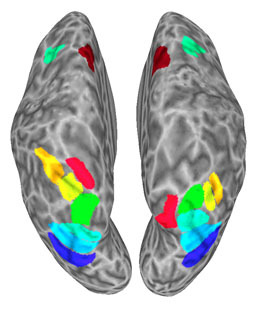Brain pathways tie together mental maps
To find its way in the world, your brain has to decipher a set of directions muddled by different points of view.
Individual neurons in the brain are constantly processing information about our surroundings, says Yuri Saalmann, psychology professor at UW–Madison, but they often use different “languages,” known as spatial reference frames.

As study subjects attended to the appearance and location of patterned tiles, researchers recorded activity in many different parts of their brain.
Image courtesy of Yuri Saalmann
“The parts at the back of the brain that process visual information from the eye tell you where an object is relative to where you’re looking,” Saalmann says. “That’s in stark contrast to the motor cortex towards the front of the brain.”
Because the motor cortex manages the muscles used to reach for and grab things, it uses a body-centered reference frame based on where an object is relative to, say, the nearest hand.
“You can imagine how those ‘languages’ may differ even for a simple task, like reaching for a drink,” Saalmann says. “If I turn my head, the location of my soda may change relative to where my eyes are fixated. But the location of the can relative to my arm or hand hasn’t changed at all. Two different neurons, two different responses and coding schemes for the location of the same object.”
It gets even more complicated in parts of the brain that examine objects’ relationships to each other, not to us.
“Some are object-centered — coding the location of one object as near to another object,” Saalmann says, “and some are what we call ‘world-centered.’ They’re organizing locations like a street map.”
Saalmann and collaborators at Princeton University published in the Proceedings of the National Academy of Sciences on Sept. 11 a description of fibers that connect parts of the brain speaking these different “languages” to a pair of central translators near the middle of the brain in the parietal cortex.

Yuri Saalmann
“We knew where this translation happens, but not how the translator gets the information to the various other areas of the brain,” says Saalmann, whose work was supported by the National Institutes of Health.
Using two types of magnetic resonance imaging, the researchers monitored activity in the brains of people performing a series of tasks aimed at working their spatial recording and recall skills.
“What we showed here is part of this translation involves multiple channels of information running from the parietal cortex in the middle of the brain between the visual and motor cortex,” Saalmann says. “It literally routes information according to behavioral goals.”
That is, there is a dedicated pipeline to the part of the brain that controls eye movements — important for quickly collecting new information about changing surroundings — and a separate pathway to the front of the brain patching in the supplementary motor cortex and its talent for higher-order movement planning.
“It helps you to make new stimulus-response associations, and act or not act accordingly,” Saalmann says. “Sometimes you might hear a sound and think, ‘In this context, that is alarming. I choose to flee.’ But if you are sitting in a movie theater, and you hear the same sound as part of the film, you’ll probably choose not to flee.”
A healthy brain has two of each of the pathways — one on each side of the brain. Understanding where they are and what they connect helps doctors anticipate the damage caused by strokes or traumatic brain injuries.
“Sometimes you might hear a sound and think, ‘In this context, that is alarming. I choose to flee.’ But if you are sitting in a movie theater, and you hear the same sound as part of the film, you’ll probably choose not to flee.”
Yuri Saalmann
“When the parietal cortex and these pathways are damaged, people have trouble encoding objects in space on the opposite side of their body,” Saalmann says. “They shave one side of their face. They eat only the food on one side of their plate. They can draw a clock face, but only fill in the numbers on one side.”
Filling in architectural gaps in the brain also carries neuroscience further away from studying only one area of the brain at a time and closer to treating the brain as multiple networks.
“These different parts of the brain all have separate functions and speak different languages when referring to the location of objects around us,” Saalmann says. “But our study shows that these brain areas are connected by information channels that allow us to manipulate objects. So we have to think of them in terms of networks that coordinate to help us perform nuanced movements.”
Tags: brain, psychology, research




